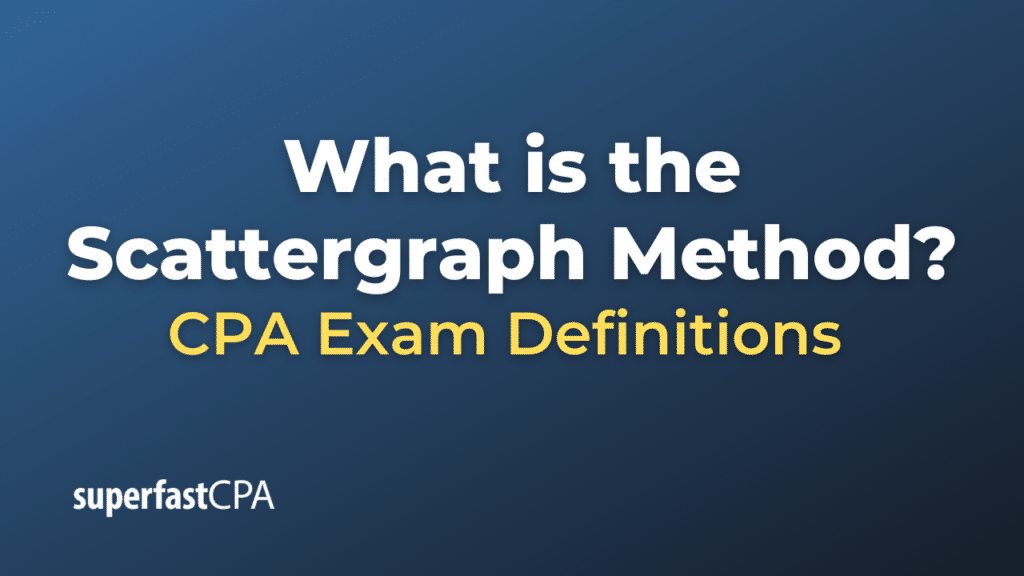Scattergraph Method
The scattergraph method is a visual technique used primarily in cost accounting and managerial decision-making to help determine the behavior of costs, especially with respect to the relationship between total costs and activity levels. It helps in estimating the variable and fixed components of a mixed cost by plotting past historical data points and then fitting a straight line (often done manually) through the scattered points.
Here’s a step-by-step explanation of the scattergraph method:
- Data Collection: Gather historical data that includes the activity level (e.g., machine hours, production volume) and the associated total cost.
- Plot Data Points: Using a scatter plot, plot the activity levels on the x-axis and the associated total costs on the y-axis. Each data point represents a period (e.g., a month or a quarter).
- Draw a Line: Manually draw a straight line that best fits the data points. This line should capture the general trend of the data points.
- Interpret the Line: The point where the line intersects the y-axis represents the estimated fixed cost (because at 0 activity level, the cost remains fixed). The slope of the line represents the variable cost per unit of activity.
- Estimate Costs: Using the interpreted line, one can estimate costs for a given activity level. The formula based on the line is y=mx+cy=mx+c, where mm is the slope (variable cost per unit of activity) and cc is the y-intercept (fixed cost).
Advantages:
- It’s a simple and straightforward method.
- It provides a visual representation of cost behavior.
- It can help in spotting outliers or irregularities in the data.
Disadvantages:
- It’s subjective since drawing the “best fit” line depends on the individual’s judgment.
- It may not be as accurate as other methods (like the high-low method or regression analysis) because it doesn’t necessarily use a mathematical approach to fit the line.
- It’s more suitable for smaller datasets; with a lot of data points, the scatter can become too difficult to interpret.
Despite its limitations, the scattergraph method can be a useful preliminary tool for understanding cost behavior, especially when combined with other methods for more rigorous analysis.
Example of the Scattergraph Method
Let’s look at a practical example involving the scattergraph method.
Suppose a small manufacturing company wants to understand the relationship between the number of units produced and the total production cost, which includes both variable and fixed costs.
Data for the Past 6 Months:
| Month | Units Produced | Total Production Cost ($) |
|---|---|---|
| Jan | 100 | 1,200 |
| Feb | 150 | 1,650 |
| Mar | 200 | 2,100 |
| Apr | 250 | 2,550 |
| May | 300 | 3,000 |
| Jun | 350 | 3,450 |
Steps:
- Plot Data Points: Plot each month’s data on a scatter plot with Units Produced (x-axis) and Total Production Cost (y-axis).
- Draw a Line: By visually examining the data points, you can see they form an upward trend. Draw a straight line that seems to fit these points best. For simplicity, let’s assume the line goes through the points (100, 1,200) and (350, 3,450).
- Interpret the Line:
- Fixed Cost: Observe where the line intersects the y-axis. Let’s say it touches the y-axis at $500. This suggests that when no units are produced, the production cost is $500, which would be the fixed cost.
- Variable Cost: To find the slope (or variable cost per unit), pick any two points on the line. Using the two points we mentioned:
- Change in cost = 3,450 – 1,200 = 2,250
- Change in units = 350 – 100 = 250
Conclusion:
From the scattergraph method, the company can estimate that for each unit produced, the production cost increases by $9 (variable cost). No matter the production level, there’s a consistent cost of $500 (fixed cost).
So, if the company plans to produce 400 units next month, the estimated production cost would be:
= (Variable cost per unit x Units) + Fixed cost
= ($9 x 400) + $500
= $3,600 + $500
= $4,100
Remember, while this method gives a reasonable estimate, it’s based on visual interpretation and past data. The actual costs can vary due to various factors not captured by this analysis.














